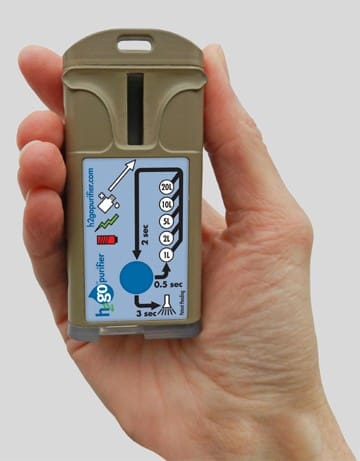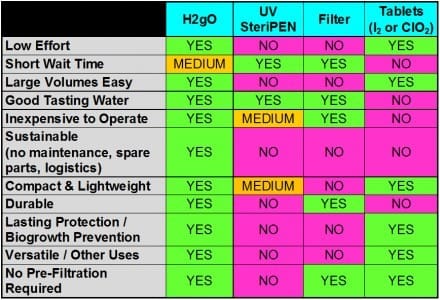Indiegogo is featuring a new project; H2gO: Quest to Create the Best Personal Water Purifier. The project’s goal is pretty impressive. They seek to “create the world’s smallest, easiest, and most cost-effective water purifier for individuals and small groups, both in developed and developing nations.”
You may have heard of the MSR Miox filter which, like the H2gO filter, uses electrolysis to process a salt brine solution to create a chlorine-based disinfectant. In fact, the H2gO Purifier can produce enough disinfectant to treat anywhere from ¼ gallon up to 5 gallons at a time (1 to 20 liters) in less than 3 minutes and will treat more than 40,000 gallons (150,000 liters) of water over its lifespan. What’s more, the disinfectant can be used for other purposes than purifying water such as washing food as well as sanitizing containers and other food prep areas.
As you know, one of the greatest challenges facing those in developing nations is access to clean water. H2gO has partnered with Safe Water International to help identify communities in need and this palm-sized device (H2gO Purifier) is the first of many planned for use for everything from individuals up to whole communities. One important component that has been added to this technology is a solar panel to ensure it will work no matter whether or not you have access to electricity.
www.indiegogo.com/projects/h2go-quest-to-create-the-best-personal-water-purifier-h2go
Tags: indiegogo




I just signed up at the $90 contribution level. I’ve used the MIOX pens and believe in this technology. This looks significantly more robust and cheaper to operate than the older MIOX pens from MSR, which was a great product. This looks perfect for deployments or travelers where pure water might be difficult to obtain.
Re-hash of old tech in a new package with a rechargeable battery. there is nothing innovative about this.
All it does is convert salt into Chlorine and hypochlorous acid, just like the Miox. These chemicals are not more effective than common bleach at treating water, and are just as ineffective at treating for crypto unless you want to wait four hours to drink water (Just like other chemical water treatments)
As far as weight goes, it is not lighter than other UV or filter options currently available.
I am not saying it would not be a good product, just that there is nothing new here in water treatment, just packaging.
Unless you need to supply multiple people, unsupported, for an extended period of time, other chemical options are lighter and do not rely on electronics, batteries, sunshine or a supply of salt (all potential failure points). For most people, other options like chlorine dioxide drops make more sense.
I’m going to largely agree with justaguy. That, and they’re a bit self-serving with dissing other technologies. As a long, long time Steripen user, I am finding it hard to come up with a reason that the Steripen somehow is not sustainable. Batteries…. sure. But the bulb on a personal model is good for something like 2,000 liters… that’s not a logistics problem. Not saying the Steripen is the end-all/be-all (especially since you need clear water first), but the chart is a bit exaggerated.
Good luck to them though! I like competition among vendors.
I do marketing for the H2gO Purifier and wanted to respond to several comments. First, thanks to SoldierSystems for sharing about our new water treatment device!
In regards to Justaguy, yes, this is indeed a 2nd generation device that utilizes the same basic technology as the MSR MIOX Purifier. However, the oxidant solution produced here is NOT the same as common bleach. Not only is chlorine (hypochlorous acid) produced, but also a bit of hydrogen peroxide. The combination means that a wider range of microorganisms are inactivated, and inactivation occurs much more rapidly than with bleach. (Note that bleach will not inactivate Crypto.)
Also, we’ve really taken into consideration feedback from the field in designing this new product. Some of the differences versus the MSR MIOX Purifier are:
• No Battery Replacement – offers over 150,000 liters of safe drinking water with no battery replacement or other replacement parts (versus the MSR MIOX requiring new batteries every 200 L).
• Solar Recharge Option – internal battery can be recharged via USB or integrated solar panel. Solar charging supplies 5 L of safe water for every 1 hour of charging.
• Easy Brine Solution – uses common table salt. Easy-to-use brine bottle holds enough brine for 10 treatments. Onboard salt storage chambers let you refill the bottle 2X.
• Treatment Volumes Up to 20L – treats anywhere from 1L up to 20L at a time.
• Flat Configuration – lies flat so you don’t have to worry about tipping, and it is still ultralight (3 oz) and compact.
• Low Cost – costs 40% less than the MSR MIOX Purifier, with no ongoing cost or replacement parts.
Also, both Steripen and H2gO are significantly lighter and smaller than filters. Both the Steripen and H2gO are comparable to one another in regards to size and weight, but you do not HAVE to pre-filter the water with H2gO to ensure that the process works. Carrying Steripen’s supplied prefilter eradicates some of the weight/volume benefits of Steripen. Also, stored water does not stay safe to drink with Steripen for an extended time, and the water container is prone to biofilm growth. Plus, you can’t use Steripen to clean other containers, surfaces, fruits, veggies, etc.
In short, different technologies are suitable for different environments and uses. For someone who is not a frequent user, chlorine dioxide drops are certainly very small and less expensive, although they do have a shelflife. I happen to think that Steripen is a pretty awesome technology, and has its benefits — the main one being instant gratification for small volumes of water. Steripen’s online literature says that the device is good for 4,000 liters (~1,000 gallons), actually. This capacity is fine for individual users in the developed world, but much less viable for emerging nations, where the cost differential really starts to build up as you treat more and more water. For a more detailed comparison, check out our web site at http://www.h2gopurifier.com/blog/why-h2go/#comparisons. I’ll also post a financial comparison table shortly that lets others see how all the different technologies rank as the amount of water treated increases. These tables should help you pick what’s best for you personally.
Attached is a link to a financial comparison of different water treatment technologies, which basically shows that for 1,000 liters of safe water or less, any of the “gadgets” (including the H2gO Purifier) are fairly comparable in cost. After only a couple hundred liters, the cost of chlorine dioxide or iodine tablets starts building up. From a financial perspective alone, this table can give shoppers a good idea of potential costs involved for the likely quantity of water they’ll be treating.
http://d2oadd98wnjs7n.cloudfront.net/medias/747820/files/20130409110624-Financial_Comparison_of_Water_Purification_Options_for_Various_Volumes_030613.pdf?1365530786
Made my contribution, keep it up